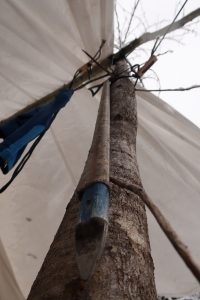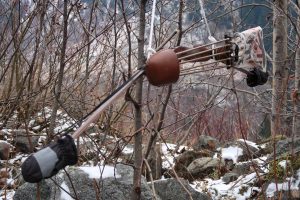The goat hunt is more than a week behind us and the ragged edge of disappointment has dulled a little. Time to provide some perspective on gear and the physical preparation.
Gear
None of our personal gear let us down, nothing really failed (not counting the cheap rubbery rain gear I bought to use during the boat and quad rides; I considered it disposable, and disposed of it got, it lasted the four days that I needed it).
Though we got a daily soaking fighting through the wet alders, we didn’t get rained on incessantly, as we had feared. It was a little colder than expected so most precipitation fell in the form of snow. The day I shot the billy was a day of constant drizzle. I used an older set of KUIU Chugach rain gear with a good soaking of a spray-on DWR just before departure, and it performed fine.
For base layers I used Icebreaker merino. 200-weight shirt and long johns and a 260-weight shirt over top of that. On days that were wet and close to freezing, a rain jacket to keep the wet and wind off was sufficient while climbing. A neck gaiter (KUIU) and a hooded jacket (Sitka Jetstream) kept the cold from creeping in from above when glassing. For prolonged periods of glassing I would put on Sitka Kelvin puffy pants and jacket.
I would definitely recommend hunting pants with knee pads. I used Sitka’s Mountain Pants. I slipped in the rocks one day, and fell onto my knee hard. The knee pad made this an event without consequence. Just for that reason, I’d wear a garment like that. But the knee pads also help when crawling over downed trees, up rocks, and other obstacles that are just too high to get a foot on them.
I used insulated boots, Lowa’s Tibet GTX Superwarm. Despite the fact that the leather got thoroughly soaked, my feet stayed mostly dry, and fairly comfortable. Some swear by more rigid boots for this type of country, but I found these to be a good middle-ground, being suitable both for the long approaches and the climbing in the rocks.
Gloves are always a big concern, since my hands get cold easily. I purchased Columbia Powder Keg skiing gloves. Guaranteed waterproof. Not sure if that was the case, the gloves got pretty wet on the inside. Could have been sweat, and ingress from the top. The good thing was that they stayed warm even when wet. However, they were hard to dry by the stove, by morning they were still damp.
After long deliberations, I left my 5 1/2 foot aspen hiking pole at home, and brought a 100cm SMC Gear Capra Ice Axe. A disadvantage is that it is loud when banged on rocks, but a big advantage is that it becomes an extended arm during climbs, and of course it might save your life if you start sliding, in a way that no trekking pole can accomplish.

Carrying the longbow through the alders was a major nuisance. I couldn’t strap it to the pack or it would get me stuck every second step, so I had to carry it by hand and feed it through the shintangle. Whenever the terrain got rocky I’d rather have the bow strapped, so I could maintain a balance using two hands. Crossing smaller rock slides I felt unstable, and of course managed to slip and bang up my shins. I really missed my long pole, but I would not have been able to carry it up some of the stuff we climbed.
I fabricated a sling from a piece of nylon rope, which, in lesser terrain, would have worked perfectly. The system I came up with to protect the tips while still having quick access to the bow needs some work. The “prototype” consisted of two baby mitts connected by bungie cord. The tip that would lead the way when fighting the alders was well-protected,, but the rear mitt got pulled off constantly. The next model would have to incorporate a non-stretchy connection between the two tip protectors, or something using snap caps. Maybe there are tip protectors commercially available, I must admit that I never looked. In the end, the bow only sustained minor scratches, though I did manage to ruin a string when I fell and it caught on a sharp rock.
In this country and this weather you will need something to protect the feathers on your arrows. I found a small dry bag that just fit over them, which kept most of the moisture off and kept damage during bushwhacking to a minimum. Similar to the mitt though, branches will want to rip it off, so make sure it is attached well.
Physical Preparation
It is hard to give advice on this, as everybody’s physique is different, and everybody’s starting point and opportunities to train are different.
Sitting behind a desk all day is not the best preparation for a multi-day hunt in goat country, or any kind of hunt really that doesn’t involve a tree stand or ground blind, but it is what I do for a living. Despite that, I try to stay fit year-round, just to have some sort of base level. I live in the happy circumstance that I live near a hill, and a fairly steep creek canyon, so I can get some base-training in just walking the dogs.
A few months before the hunt I started focusing on prolonged periods of daily work-outs, without getting too extreme on any individual day. The body is aging, and I found that extremes of anything increase the chances of injury. For me, and you will have to figure out if that also applies to you, daily work-outs, with very few exceptions, are the key. Focus on cardio, with added weights if you can.
If you can run (meaning you don’t have any injuries that prevent it), hill running is an excellent way to train legs and cardio, provided you have hills (or stairs). Hiking up and down hill (or stairs) with a weighted pack is very useful too (I would call it essential), just be careful with the knees. Add some push-ups, pull-ups and core, and you’ll have a good start. Mix things up, run or hike on uneven ground if you can, do side-hills, pick up and put down heavier, awkward things, and so on. There are many online resources to help you pick the exercises that feel right for you.
The last week or two before the hunt I picked out the steepest slope I could find close to home and went up and down, and up and down, with light or no weight. On the weekends I added in longer hikes, which would give me a few hours of continuous climbing, again with limited weight. A shoulder problem prevented me from doing any kind of serious upper body weight work, even the amount of bow shooting had to be moderated. It was not ideal, but it was what I could do.
I could definitely have been in better shape, but I feel I was adequately prepared, nobody had to wait for me. By day 6 I was feeling the strain, but this was likely partially caused by the deception of losing the billy. For the next hunt I wouldn’t change much. Focus on daily climbing for a long period of time (I probably didn’t skip a day for two months), and add in whatever keep things fun. I will work on upper-body strength though, and core, so I might actually be able to pick up and carry a moose quarter next fall. Who am I kidding, I’ll settle for being able to stumble back to camp with a quarter in my pack, I’m going to need help to get it in my pack and get to my feet.
One last comment on shooting: as much as you can, get away from formal-stance shooting across flat ground. I don’t think I saw any piece of ground where a nice standing horizontal shot would have been possible. Shoot from the knees, from two knees, shoot up, shoot down, from behind cover, standing on a slippery sloped surface, and so forth. Even though I never got to draw the bow during the hunt, trust me on this one. You won’t regret it.
Questions
I just picked a few topics to comment on that I thought would be of interest. If you have any specific question regarding gear or training, just email me. If you have any tips or tricks for mountain hunting with a trad bow that are worth sharing, please comment below.
FD
Two exercises I forgot to mention:
1. Walking lunges
Really good for working the quads, I go up to three to five sets of 50. I don’t use weights because my knees are wobbly, but if you can, adding some weights makes this a very good leg work-out, especially if you don’t have hills nearby. Find an uneven trail, or a slight uphill to make it even better.
2. Walking leg lifts
I do three kinds: leg straight out ahead (like marching in a Chinese army parade), picking up my feet sideways, up and over (like you are standing touching a big downed tree and lifting your feet up and over), and bringing up my feet with the knees outwards, touching the heels with my hand every time. These really work the groin/hip flexor area. Do this with your heavy boots on to simulate hiking through blow-down. The first exercise I have done up to 250 reps without rest, but usually I do three sets of 50 each, one set being 50 straight, 50 “step overs” and 50 “heel to hand” without rest.